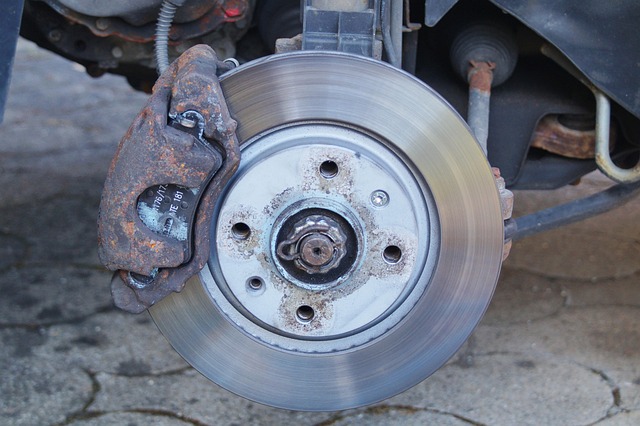Brake fluid is essential for vehicle safety, with different types catering to specific needs. Low levels trigger dashboard warnings, requiring drivers to check and maintain their brake systems. Regular checks and eco-friendly options extend braking life. Choosing correct brake fluid (as per owner's manual) is critical for performance and safety. Proper replacement involves specific tools, careful disposal, and supporting the vehicle. Optimal brake performance prevents accidents, reduces wear, and ensures compliance with safety standards through regular maintenance and informed choices about select Brake Systems.
Low brake fluid can compromise your vehicle’s stopping power, making it a critical issue to address promptly. This comprehensive guide walks you through understanding brake fluid basics, recognizing symptoms of low fluid, choosing the right fluid for your select brake system, replacing it safely, and maintaining peak performance. By following these steps, you’ll ensure your brakes remain in top shape, enhancing both safety and control on the road.
- Understand Brake Fluid Basics
- Identify Low Brake Fluid Symptoms
- Select the Right Brake Fluid for Your System
- Steps to Replace Brake Fluid Safely
- Maintain Optimal Brake Performance
Understand Brake Fluid Basics

Brake fluid is a critical component in your vehicle’s safety system. Understanding its basics is essential when addressing issues like low levels or considering upgrades, especially when selecting brake systems. Different types of brake fluids are designed for specific purposes; from conventional glycol-monoterpenes (GMB) to more modern synthetic options, each has unique properties and benefits. For instance, green braking solutions have gained popularity in eco-friendly cars, offering reduced environmental impact without compromising performance.
When it comes to fixing low brake fluid, the first step is identifying the issue. Many modern vehicles have indicators that alert drivers when fluid levels are low. This prompts a closer look at the brake system, which might involve assessing whether rebuilt brake calipers for sale are needed or if a simple top-up with the appropriate brake fluid type and uses will suffice. Regular maintenance and using the correct fluid can extend the life of your braking components, ensuring safe and efficient stopping power.
Identify Low Brake Fluid Symptoms

Recognizing the signs of low brake fluid is crucial for maintaining safe driving conditions, especially in demanding vehicles like sports cars or commercial trucks that rely on precise brake systems. One of the most common symptoms is a warning light on your dashboard indicating a problem with the brake system. This light often resembles a brake icon or a exclamation mark inside a triangle, signaling potential issues.
Additionally, drivers should pay attention to performance changes during braking. If you notice longer stopping distances, pulsing or vibration while braking, or even a high-pitched squealing noise, these could be indicators of low fluid levels. Emergency brake failure prevention becomes a priority when fluid is critically low, making it essential to address the issue promptly for the safety of both driver and passengers, as well as other road users. For commercial vehicle brake servicing, regular checks and top-ups are vital to ensure smooth operations and adhere to industry safety standards.
Select the Right Brake Fluid for Your System

When addressing brake fluid concerns, it’s paramount to Select the Right Brake Fluid for your specific brake system. Different vehicles have varying requirements based on their make and model, with considerations like temperature ratings and viscosity playing crucial roles in ensuring optimal performance and safety. Always refer to your vehicle’s owner manual or consult an auto repair specialist to determine the appropriate type of brake fluid designed for your system.
For those owning pre-driven cars, a thorough brake check by professionals is recommended before replacing the brake fluid. Moreover, with the rise of electric vehicles featuring regenerative braking systems, understanding the unique fluid requirements for such advanced brakes is essential. Fortunately, many auto brake repair services near me are equipped to guide drivers in choosing and installing the correct brake fluid tailored to their vehicle’s needs.
Steps to Replace Brake Fluid Safely

Replacing brake fluid is a crucial part of regular vehicle maintenance. It’s essential to follow safe practices to ensure optimal brake performance and your safety on the road. Start by identifying the right brake system components, as different vehicles may require specific types of fluid and containers. When selecting your new brake fluid, consider high-quality options that meet or exceed the manufacturer’s recommended specifications. Always refer to your vehicle owner’s manual for the correct type and viscosity.
Next, gather the necessary tools, including a jack, jack stands, a new container for the old fluid, and a suitable replacement. Park your car on a level surface and engage the parking brake. Remove the brake fluid cap, and carefully pour the old fluid into its designated container, ensuring not to spill any onto hot components. Replace the cap securely, then use the jack and stands to raise and support the vehicle safely. Now, you can locate the brake fluid lines and carefully remove them from their connections, allowing the remaining fluid to drain completely. Reinstall the lines, ensuring they’re secure, before filling the system with fresh brake fluid, checking for any leaks at each connection point. Remember, proper maintenance practices, including regular checks and adherence to brake safety standards and regulations, contribute to improved braking efficiency and reduced brake dust accumulation.
Maintain Optimal Brake Performance

Maintaining optimal brake performance is crucial for both safety and the longevity of your vehicle. Regularly checking and replacing brake fluid is a key aspect often overlooked in auto maintenance routines. Brake systems, when functioning optimally, ensure that vehicles stop smoothly and efficiently, preventing accidents and reducing the risk of wear and tear on other components.
Selecting the right brake systems and adhering to recommended maintenance schedules, such as those outlined by vehicle manufacturers, can help prevent costly repairs. Auto brake repair services near me offer professional solutions tailored to individual needs. Moreover, staying informed about brake safety standards and regulations ensures that your vehicle’s braking system meets industry requirements, enhancing overall driving experience and peace of mind. For those seeking comprehensive care, best brake maintenance packages provide a range of services designed to keep brakes in top condition, ensuring both performance and reliability on the road.
Regularly checking and maintaining your brake fluid is a crucial aspect of vehicle ownership. By understanding the basics, recognizing symptoms of low fluid, and selecting the appropriate type for your specific brake system (as highlighted by our SEO keyword focus), you can ensure optimal brake performance. Following safe replacement procedures will not only enhance safety but also contribute to the longevity of your vehicle’s braking system. Remember, staying proactive with brake fluid maintenance is key to avoiding unexpected issues on the road.
